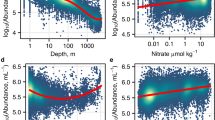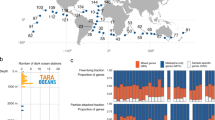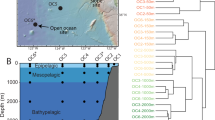Abstract
The dark ocean is one of the largest biomes on Earth, with critical roles in organic matter remineralization and global carbon sequestration. Despite its recognized importance, little is known about some key microbial players, such as the community of heterotrophic protists (HP), which are likely the main consumers of prokaryotic biomass. To investigate this microbial component at a global scale, we determined their abundance and biomass in deepwater column samples from the Malaspina 2010 circumnavigation using a combination of epifluorescence microscopy and flow cytometry. HP were ubiquitously found at all depths investigated down to 4000 m. HP abundances decreased with depth, from an average of 72±19 cells ml−1 in mesopelagic waters down to 11±1 cells ml−1 in bathypelagic waters, whereas their total biomass decreased from 280±46 to 50±14 pg C ml−1. The parameters that better explained the variance of HP abundance were depth and prokaryote abundance, and to lesser extent oxygen concentration. The generally good correlation with prokaryotic abundance suggested active grazing of HP on prokaryotes. On a finer scale, the prokaryote:HP abundance ratio varied at a regional scale, and sites with the highest ratios exhibited a larger contribution of fungi molecular signal. Our study is a step forward towards determining the relationship between HP and their environment, unveiling their importance as players in the dark ocean’s microbial food web.
Similar content being viewed by others
Log in or create a free account to read this content
Gain free access to this article, as well as selected content from this journal and more on nature.com
or
References
Andersen P, Fenchel T . (1985). Bacterivory by microheterotrophic flagellates in seawater samples. Limnol Oceanogr 30: 198–202.
Arístegui J, Duarte CM, Gasol JM, Herndl GJ . (2009). Microbial oceanography of the dark ocean’s pelagic realm. Limnol Oceanogr 54: 1501–1529.
Baltar F, Arístegui J, Sintes E, Van Aken HM, Gasol JM, Herndl GJ . (2009). Evidence of prokaryotic metabolism on suspended particulate organic matter in the dark waters of the subtropical North Atlantic. Limnol Oceanogr 54: 182–193.
Boras JA, Sala MM, Baltar F, Arístegui J, Duarte CM, Vaqué D . (2010). Effect of viruses and protists on bacteria in eddies of the Canary Current region (subtropical northeast Atlantic). Limnol Oceanogr 55: 885–898.
Brussaard CPD . (2004). Optimization of procedures for counting viruses by flow cytometry. Appl Environ Microbiol 70: 1506–1513.
Calvo-Díaz A, Morán XAG, Suárez LÁ . (2008). Seasonality of picophytoplankton chlorophyll a and biomass in the central Cantabrian Sea, southern Bay of Biscay. J Mar Syst 72: 271–281.
Cho BC, Na SC, Choi DH . (2000). Active ingestion of fluorescently labelled bacteria by mesopelagic heterotrophic nanoflagellates in the East Sea, Korea. Mar Ecol Prog Ser 206: 23–32.
Christaki U, Courties C, Massana R, Catalá P, Lebaron P, Gasol JM et al. (2011). Optimized routine flow cytometric enumeration of heterotrophic flagellates using SYBR Green I. Limnol Oceanogr 9: 329–339.
Dick GJ, Anantharaman K, Baker BJ, Li M, Reed DC, Sheik CS . (2013). The microbiology of deep-sea hydrothermal vent plumes: ecological and biogeographic linkages to seafloor and water column habitats. Front Microbiol 4: 124.
Fukuda H, Sohrin R, Nagata T, Koike I . (2007). Size distribution and biomass of nanoflagellates in meso- and bathypelagic layers of the subarctic Pacific. Aquat Microb Ecol 46: 203–207.
Gasol JM, Alonso-Sáez L, Vaqué D, Baltar F, Calleja ML, Duarte CM et al. (2009). Mesopelagic prokaryotic bulk and single-cell heterotrophic activity and community composition in the NW Africa–Canary Islands coastal-transition zone. Prog Oceanogr 83: 189–196.
Gasol JM, del Giorgio PA . (2000). Using flow cytometry for counting natural planktonic bacteria and understanding the structure of planktonic bacterial communities. Sci Mar 64: 197–224.
Gundersen K, Heldal M, Norland S, Purdie DA, Knap AH . (2002). Elemental C, N, and P cell content of individual bacteria bollected at the Bermuda Atlantic Time-Series Study (BATS) Site. Limnol Oceanogr 47: 1525–1530.
Hillebrand H, Dürselen C-D, Kirschtel D, Pollingher U, Zohary T . (1999). Biovolume calculation for pelagic and benthic microalgae. J Phycol 35: 403–424.
Jiao N, Zheng Q . (2011). The microbial carbon pump: from genes to ecosystems. Appl Environ Microbiol 77: 7439–7444.
Jürgens K, Massana R . (2008). Protistan grazing on marine bacterioplankton. In: Kirchman DL (ed) Microbial Ecology of the Oceans 2nd edn Wiley: New York, NY, USA, pp 383–441.
Kirchman DL, Keil RG, Wheeler PA . (1989). The effect of amino acids on ammonium utilization and regeneration by heterotrophic bacteria in the subarctic Pacific. Deep-Sea Res 36: 1763–1776.
Lim EL, Dennet MR, Caron DA . (1999). The ecology of Paraphysomonas imperforata based on studies employing oligonucleotide probe identification in coastal water samples and enrichment cultures. Limnol Oceanogr 44: 37–51.
Marie D, Brussaard CPD, Thyrhaug R, Bratbak G, Vaulot D . (1999). Enumeration of marine viruses in culture and natural samples by flow cytometry. Appl Environ Microbiol 65: 45–52.
Marie D, Simon N, Vaulot D . (2005). Phytoplankton cell counting by flow cytometry. In: Andersen RA (ed) Algal Culturing Techniques. Academic Press: New York, NY, USA, pp 253–267.
Massana R, Terrado R, Forn I, Lovejoy C, Pedrós-Alió C . (2006). Distribution and abundance of uncultured heterotrophic flagellates in the world oceans. Environ Microbiol 8: 1515–1522.
Menden-Deuer S, Lessard EJ . (2000). Carbon to volume relationship for dinoflagellates, diatoms and other protist plankton. Limnol Oceanogr 45: 569–579.
Morgan-Smith D, Clouse MA, Herndl GJ, Bochdansky AB . (2013). Diversity and distribution of microbial eukaryotes in the deep tropical and subtropical North Atlantic Ocean. Deep-Sea Res Part I 78: 58–69.
Morgan-Smith D, Herndl GJ, van Aken HM, Bochdansky AB . (2011). Abundance of eukaryotic microbes in the deep subtropical North Atlantic. Aquat Microb Ecol 65: 103–115.
Nagata T, Tamburini C, Arístegui J, Baltar F, Bochdansky AB, Fonda-Umani S et al. (2010). Emerging concepts on microbial processes in the bathypelagic ocean—ecology, biogeochemistry, and genomics. Deep-Sea Res Part II 57: 1519–1536.
Pernthaler J, Glöckner F, Schönhuber W, Amann R . (2001). Fluorescence in situ hybridization (FISH) with rRNA-targeted oligonucleotide probes. Method Microbiol 30: 207–226.
Pomeroy LR, Johannes RE . (1968). Respiration of ultraplankton in the upper 500 meters of the ocean. Deep-Sea Res 15: 381–391.
Porter K, Feig Y . (1980). The use of DAPI for identifying and counting aquatic microflora. Limnol Oceanogr 25: 943–948.
Richards TA, Jones MDM, Leonard G, Bass D . (2012). Marine fungi: their ecology and molecular diversity. Ann Rev Mar Sci 4: 495–522.
Schiltzer R . (2013). Ocean Data View. Available at: http://odv.awi.de (accessed 13 June 2012).
Simon M, Grossart H-P, Schweitzer B, Ploug H . (2002). Microbial ecology of organic aggregates in aquatic ecosystems. Aquat Microb Ecol 28: 175–211.
Sohrin R, Imazawa M, Fukuda H, Suzuki Y . (2010). Full-depth profiles of prokaryotes, heterotrophic nanoflagellates, and ciliates along a transect from the equatorial to the subarctic central Pacific Ocean. Deep-Sea Res Part II 57: 1537–1550.
Sorokin YI . (1985). Phosphorus metabolism in planktonic communities of the Eastern Tropical Pacific. Mar Ecol Prog Ser 27: 87–97.
Steward GF, Montiel JL, Azam F . (2000). Genome size distributions indicate variability and similarities among marine viral assemblages from diverse environments. Limnol Oceanogr 45: 1697–1709.
Tanaka T, Rassoulzadegan F . (2002). Full-depth profile (0–2000 m) of bacteria, heterotrophic nanoflagellates and ciliates in the NW Mediterranean Sea: vertical partitioning of microbial trophic structures. Deep-Sea Res Part II 49: 2093–2107.
Tanaka T, Rassoulzadegan F, Thingstad TF . (2005). Analyzing the trophic link between the mesopelagic microbial loop and zooplankton from observed depth profiles of bacteria and protozoa. Biogeosciences 2: 9–13.
Wommack EK, Ravel J, Hill RT, Chun J, Colwell RR . (1999). Population dynamics of Chesapeake Bay virioplankton: total-community analysis by pulse-field gel electrophoresis. Appl Environ Microbiol 65: 231–240.
Yamaguchi A, Watanabe Y, Ishida H, Harimoto T, Furusawa K, Suzuki S et al. (2002). Structure and size distribution of plankton communities down to the greater depths in the western North Pacific Ocean. Deep-Sea Res Part II 49: 5513–5529.
Yamaguchi A, Watanabe Y, Ishida H, Harimoto T, Furusawa K, Suzuki S et al. (2004). Latitudinal differences in the planktonic biomass and community structure down to the greater depths in the western north Pacific. J Oceanogr 60: 773–787.
Zubkov MV, Burkill PH . (2006). Syringe pumped high speed flow cytometry of oceanic phytoplankton. Cytometry Part A 69A: 1010–1019.
Zubkov MV, Burkill PH, Topping JN . (2007). Flow cytometric enumeration of DNA-stained oceanic planktonic protists. J Plankton Res 29: 79–86.
Acknowledgements
This study was supported by the Spanish Ministry of Science and Innovation through project Consolider-Ingenio Malaspina 2010 (CSD2008-00077) (to CMD) and FLAME (CGL2010-16304) (to RM). We thank our fellow scientists, the crew and chief scientists of the different cruise legs for collaboration.
Author information
Authors and Affiliations
Corresponding authors
Ethics declarations
Competing interests
The authors declare no conflict of interest.
Additional information
Supplementary Information accompanies this paper on The ISME Journal website
Rights and permissions
About this article
Cite this article
Pernice, M., Forn, I., Gomes, A. et al. Global abundance of planktonic heterotrophic protists in the deep ocean. ISME J 9, 782–792 (2015). https://doi.org/10.1038/ismej.2014.168
Received:
Revised:
Accepted:
Published:
Issue date:
DOI: https://doi.org/10.1038/ismej.2014.168
This article is cited by
-
Ocean-wide comparisons of mesopelagic planktonic community structures
ISME Communications (2023)
-
Evaluating sediment and water sampling methods for the estimation of deep-sea biodiversity using environmental DNA
Scientific Reports (2021)
-
Gene expression during bacterivorous growth of a widespread marine heterotrophic flagellate
The ISME Journal (2021)
-
Cryptophyta as major bacterivores in freshwater summer plankton
The ISME Journal (2018)
-
Probing the evolution, ecology and physiology of marine protists using transcriptomics
Nature Reviews Microbiology (2017)



